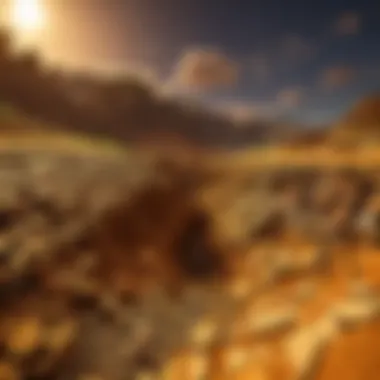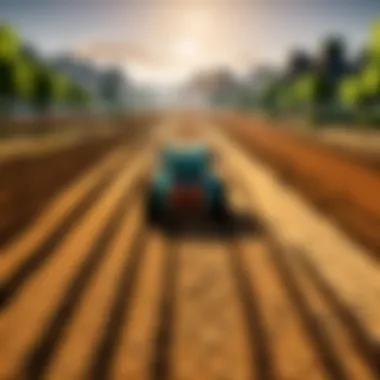Understanding Dirt in Minecraft: A Detailed Insight


Intro
Dirt might seem like the humble underdog of the Minecraft world, often overlooked amidst a sea of more glamorous blocks. Yet, this basic resource is a cornerstone of the game's intricate mechanics. Understanding dirt is essential for anyone who wants to fully engage with Minecraft, as it lays the foundation for everything from building to survival.
In the following sections, we will explore the origins, uses, and the interactions of dirt within the game universe. By dissecting this unassuming material, players can gain a new perspective on what it means to craft, create, and conquer in Minecraft's sandbox world.
Let's delve into the dirt, pun intended!
Understanding the Nature of Dirt
Dirt, often regarded as the most basic of building materials in Minecraft, serves a pivotal role that transcends mere aesthetics. This section seeks to clarify the various dimensions of dirt, exploring its fundamental characteristics and examining why it’s more than just a simple block. Within the framework of gameplay mechanics, dirt becomes a keystone that supports a player’s creativity and resource management strategies.
Defining Dirt in Minecraft
In Minecraft, dirt is classified as a solid block. While it appears unassuming at first glance, dirt serves a multifaceted purpose within the world of the game. Defined by its brownish color and rough texture, dirt can be found abundantly in almost every biome—be it plains, forests, or even mountains. Each block plays a significant role in environmental structure, acting as the foundation upon which players build their dreams. Without a clear understanding of these properties, players may overlook the potential dirt has for crafting entire landscapes or even utilitarian structures.
Beyond just a building block, dirt also comes with specific properties that favor gaming mechanics. For instance, it can be tilled using a hoe, which is an important action for starting a farm. Thus, it transforms from an ordinary block into a fertile ground capable of yielding crops.
In addition, dirt can be crafted into other useful items. Players can use it to create paths, enhance visibility, or mark areas of interest within their worlds. No less important than the glitzy blocks that grab the spotlight, dirt has a unique significance that often goes acknowledged.
Dirt Versus Other Block Types
When contrasting dirt with other block types in Minecraft, one begins to appreciate its unique attributes. Unlike stone or ores that often require specialized tools to mine, dirt can be easily collected with just a hand or any tool, offering an accessible resource from the very beginning of a player’s journey.
Moreover, while dirt shares similarities with grass blocks, there are significant differences. Grass blocks, for instance, are capable of supporting vegetation and spreading grass to adjacent dirt blocks, thus offering a green aesthetic that dirt itself does not provide. This capability makes grass blocks preferable for landscaping and decorative purposes.
"Dirt is the foundation of possibility in Minecraft—a humble block with grand potential."
On the other end of the spectrum, we have blocks like gravel or sand. Although these materials can also be mined easily, they are often evaluated based on their different properties. Gravel, for instance, is known for its ability to fall when disturbed while sand can float if placed above water. Such distinctions create layers of complexity in building and resource gathering, but it is dirt that often remains consistent in its availability and utility across a range of crafting scenarios.
As players navigate through their Minecraft adventures, understanding the nuances of dirt compared to other block types can lead to more informed choices in construction and gameplay strategies. Recognizing these differences is vital for any player aspiring to create a balanced and strategically advantageous environment.
The Functionality of Dirt
Dirt may look like an unassuming building block in Minecraft, but its functionality runs deep in gameplay and design. The ability to modify landscapes, cultivate crops, and even construct devices puts this material in the spotlight. Understanding how dirt operates can unveil strategies that maximize player potential in various game modes. Knowledge of its utility not only aids players in everyday activities but also enhances creativity, allowing for innovative designs in structures and farms alike. The versatility of dirt serves a myriad of purposes; below we explore some key aspects of its functionality.
Building and Terrain Modification
When it comes to shaping the Minecraft world, dirt takes the lead. It's the go-to block for builders looking to creatively alter the environment. One of the key characteristics of dirt is its simplicity. Unlike more complex materials, dirt is typically abundant and easy to gather. As a result, players can freely manipulate their surroundings without the fear of running low on resources. This opens up a world of possibilities for landscape design.
For example, dirt can be used to create slopes, hills, or entirely new terrains. Players might often find themselves using dirt to construct pathways or to temporarily elevate structures when they're laying out more permanent buildings. Its ease of placement means players can quickly adapt their environment to suit their needs.
"Dirt is not just the foundation of our builds; it’s the canvas upon which our creativity flourishes."


Agricultural Applications
Growing Crops
When talking about agricultural practices in Minecraft, dirt is indispensable. It serves as the primary medium for growing crops. Crops like wheat, carrots, potatoes, and beetroot thrive on cultivated dirt blocks that have been properly irrigated. This aspect of dirt is crucial because successful agriculture not only sustains players but can also lead to economic advancements through trading with villagers.
The unique feature here is that dirt becomes farmland when tilled, which allows for better crop growth. Unlike regular dirt, farmland can’t be too far removed from water; this hydration is essential. However, if neglected, farmland can revert to ordinary dirt, meaning that players must keep an eye on their agricultural spots. Following this, the requirement of water—although a small hindrance—adds an interesting layer of depth to farming strategies. Thus, growing crops on dirt contributes greatly to food sustainability, making it a popular choice amongst players.
Using Dirt for Animal Farms
Dirt serves a functional role in animal husbandry as well. It provides a solid foundation on which farms can be built to house livestock. Using dirt for animal farms can prove beneficial as it is mostly flat and requires minimal effort to setup.
One of the key characteristics of this approach is that dirt is more forgiving than other materials when it comes to leading animals around. If players decide to build pens or fences for animals, they often easily manage the environment due to the forgiving nature of dirt.
- Advantages:
- Disadvantages:
- Abundance of dirt makes it readily available;
- Dirt blocks are easy to manipulate, allowing for creative farm designs.
- Without proper fencing, animals may wander off, causing potential setbacks in farm management.
- If overused, the appearance of farms can become bland when not supplemented with more visually appealing blocks.
Therefore, utilizing dirt in animal farming not only aids in development of self-sustaining resources but also provides a functional yet straightforward way to manage livestock.
Use in Redstone Mechanisms
Dirt also finds its place in the mechanized world of Redstone. While it might not be as flashy as some materials, dirt serves as a grounding or support block for various Redstone contraptions. The simplicity of dirt lends itself well to being easily placed alongside more complex Redstone components, creating a solid foundation for mechanisms. Players have used dirt as a temporary block during Redstone creations, only to replace it later without fear of it being missed in the myriad of circuits.
In summary, dirt’s adaptability across different functionalities in Minecraft emphasizes its critical role in the game. By understanding how to manipulate and utilize this foundational material, players can explore the numerous possibilities it presents for building, farming, and crafting innovative mechanisms.
The Varieties of Dirt
Exploring the various types of dirt in Minecraft opens up a fascinating discussion about the nuances of gameplay and creativity. Each dirt variety brings unique properties and potential, influencing everything from crop growth to the aesthetic of a build. Understanding these differences is crucial for players who seek to optimize their environments and harness the full potential of Minecraft’s mechanics. Here, we will take a closer look at some of the most notable dirt types in the game, illuminating their applications and significance in a player's journey through the blocky landscapes.
Grass Block and Dirt Differences
At first glance, grass blocks and dirt seem similar, but they serve distinct roles that affect gameplay. Dirt is the more basic form found abundantly on the surface, recognizable by its brown hue. It's an ideal initial material for any building project, acting as a fundamental building block for layering.
In contrast, grass blocks come primarily from dirt that has been exposed to light. When a dirt block receives enough sunlight, it transforms, gaining a vibrant green top. This transformation is not merely aesthetic; it allows players to grow a variety of plants, primarily grasses and wildflowers. Players should note that the growth of grass is contingent upon several factors: light levels, adjacent grass blocks, and biome types. Understanding these conditions empowers players to cultivate their spaces more effectively.
Coarse Dirt and Its Applications
Next up is coarse dirt, which is a blend of gravel and dirt. The textural change introduces a rougher look, and it also has a notable trait: plants cannot grow on it. This particular characteristic makes coarse dirt valuable for specific landscaping needs or paths where players want to avoid unwanted plant growth.
Players often utilize coarse dirt for constructing pathways that lead to important structures while keeping the area clear of overgrowth. Additionally, it plays a role in aesthetic builds, providing varied soil colors that cater to the design vision. When paired with gravel, it creates a rugged, natural look that can enhance the charm of a build.


Podzol and Mycelium
Diving deeper into the variety of dirt, we encounter podzol and mycelium, both unique in their qualities. Podzol is a special type of dirt found primarily in taiga biomes, and it introduces the ability to grow specific plant life, such as spruce trees, not found on standard dirt. This can lead to interesting possibilities for forest-themed builds or survival strategies focused on harvesting the abundant wood resources.
In contrast, mycelium is fascinating for its moist-looking texture. It is found in the dark forest and is essential for mushroom growth, allowing players to cultivate mushrooms more rapidly compared to regular dirt. This soil variety serves a practical function for food resources, and its distinct color can be used strategically in decorative projects, adding to the vibrant aesthetics of builds.
These diverse forms of dirt illustrate the in-depth layers of Minecraft's world, showing that even the simplest components can have extraordinary implications. Understanding the various dirt types allows players to elevate their gameplay, opening avenues for creativity and strategy that enhance their Minecraft experience.
Environmental Interactions with Dirt
Dirt in Minecraft is more than just a block used for building; it plays a vital role in the overarching environment of the game. Understanding how dirt interacts with various elements in the game grants players insights that can enhance their gameplay experience. Not only does dirt affect terrain aesthetics, but it also influences gameplay mechanics significantly. This section delves into two critical aspects: the relationship between water saturation and dirt, as well as the effects of different biomes on dirt types.
Water Saturation and Dirt
Water saturation is crucial in determining how dirt behaves and affects plant growth within Minecraft. Dirt blocks, especially grass blocks, can absorb water, which is vital for successful farming and vegetation. When dirt is exposed to water, it becomes more fruitful, allowing crops planted in it to grow faster and mature fully.
In a practical sense, this means if players want to maximize their harvests, they should think strategically about where and how they place their crops. Here are some points to consider:
- Irrigation: Using water to irrigate dirt effectively allows a player to maintain an abundant food supply. By placing water sources within a four-block radius of tilled farmland, players can ensure their crops have sufficient moisture.
- Flooding Effects: On the flip side, over-saturation can be detrimental. Too much water can lead to mud, potentially impacting the growth of crops, which might cause players to rethink how bodies of water are used around their farms.
- Drainage: There are instances where players might want to drain water away from certain areas to keep dirt viable and maintain farm efficiency. Constructing canals or using other blocks can aid in directing excess water away.
"Maintaining balance in water saturation transforms dirt from a mere building block into a core element of your agricultural strategy."
Effects of Biomes on Dirt Type
Biomes in Minecraft are more than just pretty landscapes — they dictate many environmental interactions, including the type of dirt players come across. Each biome hosts specific dirt varieties, which can influence gameplay strategies and aesthetic choices. For instance:
- Forest Biomes: Commonly feature grass blocks and dirt, often giving players fertile ground to build their farms.
- Desert Biomes: Here, players will find coarse dirt more frequently. This type does not allow grasses to grow, presenting unique challenges for players looking to cultivate plants.
- Swamp Biomes: Characterized by a mix of regular dirt and mud. The mud makes the terrain swampy and alters how players navigate and build in these areas.
Understanding the connections between biomes and dirt types is crucial for players, as it impacts their building strategies and resource gathering. Players should assess their location's biome and adapt their plans accordingly to maximize efficiency and creativity.
In summary, dirt in Minecraft is deeply affected by environmental factors such as water saturation and the characteristics of biomes. Embracing these interactions helps players harness the full potential of dirt, making their crafting and farming endeavors more fruitful and enjoyable.
Mining and Collecting Dirt
Dirt is often overlooked in Minecraft; however, mining and collecting this seemingly simple resource holds substantial importance. Understanding how to effectively gather dirt not only helps bolster your building repertoire but also plays a significant role in various aspects of gameplay. Whether you’re a beginner trying to establish your first farm or a seasoned player crafting complex structures, knowing the best practices for dirt collection can save time and resources. Moreover, dirt serves as a foundation for many essential activities, from landscaping to agriculture.
Best Strategies for Dirt Collection
When it comes to collecting dirt, certain strategies can make the task simpler and more efficient. Here are a few effective techniques:
- Use the Right Tools: While dirt can be mined with any shovel or even by hand, using a shovel will speed up the process. A diamond or iron shovel enhances efficiency more than wooden or stone shovels.
- Target Dirt Patches: Focus on larger patches of dirt in your surroundings. This allows you to gather more in a shorter amount of time. Always keep an eye out for naturally occurring areas like forests, fields, and hills.
- Layered Mining: When dealing with dirt layers, mine from the top down. This strategy helps to prevent falling into holes or pits and may also reveal other resources beneath the surface.
- Coordinate with Terrain: Utilize natural obstacles or features to your advantage. For instance, dirt can sometimes be easier to collect near water bodies or mountains.
By implementing these strategies, players can enhance their dirt-gathering efforts and make each excursion productive.


Dirt in Survival Mode versus Creative Mode
In Survival Mode, dirt acts as a vital resource that players must gather actively. The process of collection takes time and energy, making it a more measured task compared to the instant availability found in Creative Mode. This difference significantly influences gameplay:
- Resource Management: In Survival Mode, players need to think critically about their resource use. Dirt might not have the fancied glitz of other blocks, but it remains a core component of creating farms, pathways, and structures.
- Utility: Players rely on dirt to grow crops, build foundations, and even for aesthetics in designs. The presence of dirt affects survival strategies—overlooking it could lead to missed farming opportunities.
Contrarily, in Creative Mode, players can summon dirt blocks freely, allowing for unrestricted building. This mode facilitates an environment where players can quickly explore creative ideas without the concern of resource exhaustion. It serves as a playground for innovative design without the labor-intensive element from Survival Mode.
"Understanding the differences in dirt utility across modes contributes to a player's overall strategy and creativity."
Dirt in Community Creations
Dirt often carries a reputation of being just a lowly building block in the Minecraft universe. However, the creative community has turned this simple material into a canvas of innovation. The flexibility of dirt in various designs and constructions reveals its hidden potential. From intricate architecture to expansive landscaping, the importance of dirt in community creations cannot be overstated. It serves as a fundamental element that enhances the creativity and resourcefulness of players.
Innovative Uses in Player Builds
In the hands of skilled builders, dirt morphs from ordinary to extraordinary. One well-known example is utilizing dirt to create a base for structures. Builders often use dirt as a temporary construction material, while they figure out designs and placements of blocks. The ease of breaking and replacing dirt makes it an ideal option for prototyping. Here’s a look at how players innovate with this material:
- Landscaping: Many players rely on dirt for creating terrain, hills, and valleys. By stacking dirt up to various elevations, gamers can make their worlds more dynamic, allowing outdoor spaces to feel more realistic.
- Temporary Structures: Builders often erect dirt scaffolding that supports more complex designs until they can replace it with sturdier materials.
- Natural Elements: Players often blend dirt into garden designs, simulating patches of earth within these greens with flowers or crops, invoking a sense of nature within their creations.
In all these scenarios, dirt becomes instrumental in enhancing gameplay experiences, often serving as a stepping stone to larger, more intricate designs.
Artistic Implementations of Dirt
The artistry of Minecraft transcends mere architecture; dirt plays its part in aesthetic expressions as well. While it may seem unremarkable, players have found ways to showcase dirt artistically. Explore some notable contributions to community art:
- Pixel Art: Though gravel and other materials often get the spotlight, dirt can effectively create larger pixel art murals when combined with contrasting materials, leading to vibrant, colorful creations.
- Sculptures: Utilizing dirt as a foundational block allows players to form sculptures that tell stories or represent characters from pop culture, all while harnessing the raw aesthetic of dirt itself.
- Themed Builds: In various biome-themed projects, dirt serves as a base layer that integrates with overall thematic elements - think of a village where huts are made from dirt, or a fantasy world where earthy tones set the mood.
The beauty of crafting with dirt lies not just in its utility, but in its unwavering ability to serve as a canvas for imagination. Every block laid tells a story.
In summary, the role of dirt in community creations within Minecraft goes well beyond what initial appearances may suggest. From practical applications in builds to artistic demonstrations that engage the imagination, dirt proves itself as a versatile component. As players continue to innovate with this commonplace material, it reshapes the community's approach to building and artistry within the game.
The Future of Dirt in Minecraft
As we peer into the distance, the landscape of Minecraft continues to evolve at a breakneck pace. Dirt, despite its seemingly rudimentary nature, may soon take center stage in future developments. Its role isn't just that of a mere placeholder; it underpins a lot of the mechanics and creative constructions within the game. Players, both casual and dedicated, should keep an eye on how dirt's functionality might broaden in the upcoming updates. Here, we explore anticipated updates and the potential mechanics that could interweave dirt even further into the gameplay.
Anticipated Updates and Changes
The Minecraft community is bubbling with speculation on what updates might be lurking around the corner. Mojang, the developers, have a penchant for surprising players, and dirt could very well benefit from this creative unpredictability. Here are some of the changes players are discussing:
- New Blocks and Variants: It wouldn’t be surprising to see new types of dirt added, each with unique properties—imagine a dirt that absorbs water, ideal for certain biomes!
- Environmental Effects: The incorporation of weather effects, where dirt could become muddy when it rains or dry out in arid conditions, seems plausible. This could not only enhance aesthetic appeal but also impact gameplay strategies.
- Crafting Mechanics: Players are hopeful that dirt could play a role in crafting new tools or items, perhaps even becoming a key ingredient in new recipes.
The Role of Dirt in Upcoming Mechanics
The potential for dirt to integrate into new mechanics presents a thrilling prospect for enhancement in gameplay. Players are already brainstorming exciting applications. Here’s what might lie ahead:
- Fluid Interactions: Future updates could have dirt interacting with fluids like water or lava in more sophisticated ways. For instance, dirt might help form temporary barriers during flooding, introducing new strategic considerations for survival.
- Biomes and Ecosystem Dynamics: Future biomes might incorporate dirt differently, affecting how players build and farm in various areas. Players might need to adapt their strategies based on the type of soil they encounter.
- Dirt as a Resource: How about new technologies that could allow players to convert dirt into other resources? This could open up a broader range of utility and recycling mechanics.
"Dirt isn't just a block; it's a foundation for creation, exploration, and survival."
In the grand scheme of Minecraft, the future of dirt is bound to be anything but ordinary. It’s about time we acknowledge this humble block’s importance in shaping our experiences. With new updates on the horizon, players have every reason to stay curious about what fun mechanics or features could be rolling out in the next update. Stay tuned to keep your dirt game on point!



